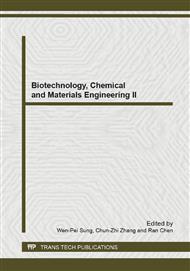p.828
p.834
p.838
p.841
p.845
p.850
p.854
p.858
p.862
Thermal Alkaline Method to Prepare Geotrichuam Candidum Protein Foaming Agent
Abstract:
Geotrichum Candidum strain numbered 2.0498 was used as raw material. The Geotrichum Candidum thallus were collected through inoculation and shaking cultivation. Thermal alkaline method was applied for hydrolyzing Geotrichum Candidum mycoprotein to prepare protein foaming agent. The effect of bacteria concentration, Ca(OH)2 mass concentration, hydrolysis temperature and hydrolysis time on foam expansion were studied. The optimization strategy was single factor test and subsequent response surface analysis based on Box-Behnken design. The results showed that the optimized condition were a bacteria concentration of 5.4%(w/v) and a Ca(OH)2 mass concentration of 1.5%(w/v), at a hydrolysis temperature of 95°C for 4.1 h. Under these optimal conditions, the foam expansion was 28.1. Compared with the model theory prediction, the relative error was 0.46%. At the same time, a multiple quadratic regression equation between Geotrichum Candidum mycoprotein foam expansion and impact factors was setted up and it played an important role in predicting the foam expansion.
Info:
Periodical:
Pages:
845-849
Citation:
Online since:
January 2013
Authors:
Keywords:
Price:
Сopyright:
© 2013 Trans Tech Publications Ltd. All Rights Reserved
Share:
Citation:


